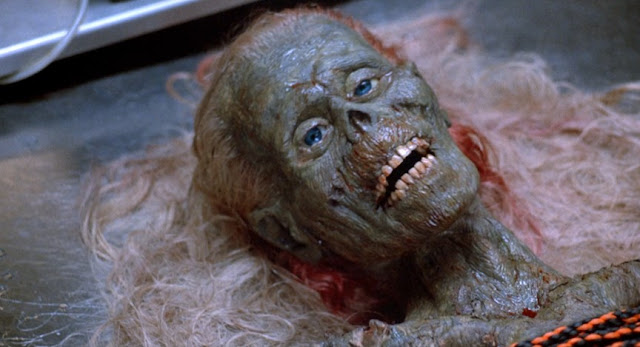
Let’s catch you up on the Italian Zombi series, which currently holds steady at four entries, despite the last chapter being titled Zombie 5: Killing Birds.
It all began with George A. Romero’s Dawn of the Dead, which was released in Italy under the title Zombi. Following that, horror director Lucio Fulci (The Beyond) made his own unrelated undead ghoul flick, which was released as Zombie in the U.S., but as Zombi 2 in Italy, therefore suggesting it was a sequel to Romero’s film. (It wasn’t.)
Following, Fulci made Zombi 3, Claudio Fragasso made Zombi 4: After Death, and Claudio Lattanzi made Zombi 5: Killing Birds, though, according to that latter’s Wiki page, “…zombies only feature in the last half hour of the movie, and only one character is attacked by birds.”
Following, Fulci made Zombi 3, Claudio Fragasso made Zombi 4: After Death, and Claudio Lattanzi made Zombi 5: Killing Birds, though, according to that latter’s Wiki page, “…zombies only feature in the last half hour of the movie, and only one character is attacked by birds.”
Meanwhile still, the Zombi films were released in Britain under the Zombie Flesh Eater moniker, which ejected Dawn of the Dead from the canon and reset the numbering scheme (Zombi 2 became Zombie Flesh Eater 1, etc.). Every territory had their own titling scheme, numbering scheme, and even added or dropped otherwise totally unrelated films to make them part of the ongoing series. (One territory added the joyfully nuts Burial Ground: The Nights of Terror, which was the best choice they could have made.) Honestly, it’s all confusing as fuck and probably not worth the effort to navigate, because when you think about it, every zombie movie ever made could be a sequel to the one that came before.
Basically, if you’re a passionate movie collector living in the U.S. AND you have OCD, your complete Zombi series would consist of Zombie, and then Zombi 3-5, and it probably kills you.
Haw haw!


Having recently revisited Fulci’s Zombie/Zombi 2 in preparation for my mini Zombi 3/4 marathon, a film I hadn’t seen for a very long time, I was expecting my newfound appreciation for Italian horror and the film’s ongoing semi-respected reputation to usher in an undiscovered enjoyment of the gory zombie shocker. That didn’t happen. Surprisingly, Zombie is actually kind of dull, relocating most of its action to an island in the Caribbean after a promising opening in which a small boat containing a handful of ghouls washes up in New York harbor.
I’m no big fan of Fulci’s films in any legitimate way (although I sort of adore City of the Living Dead), but despite his very diverging outputs of quality, the man at least had a distinct visual style, which makes Zombi 3 feel so odd. Zombi 3 is just stupidity, featuring flying, biting zombie heads and one action set piece after another. And the gore! So much gore! Sadly, there’s a reason for this. Fulci (who was very ill during filming) and two ghost directors Claudio Fragasso (the film’s screenwriter) and Bruno Mattei (Italian shlockmeister director of the highest order) present Zombi 3 as a more ridiculous and action-packed experience. Whatever sense of mood, or satire, or “moral” Fulci was vying for in Zombie has gone right out the window here (or perhaps was phased out after some of Fulci’s footage was tossed and replaced with new material from his collaborators). Plotwise, Zombi 3 takes somewhat of a page from Romero’s The Crazies with the presence of hazmat-suited soldiers laying waste to anything deemed a threat, as well as Return of the Living Dead, relying heavily on the idea of the zombie scourge spreading across the landscape from the cremation of infected corpses. The zombies are also of the running variety. But Zombi 3 is also much funnier than that beloved zombie comedy, even though it wasn’t trying to be. Hysterical overroughtness tends to happen when you’re dealing with an Italian horror production, usually aided by the overly emphatic dubbing which offers every character a very animated and highly emotional presence.
(And again, flying zombie head.)
Picking on Zombi 3’s lack of plot feels like low-hanging fruit given the Frankensteinian nature of its production, but I’ll go ahead and say it anyway: there’s barely a plot beyond a couple groups of wandering people intermittently finding each other, running afoul of ghouls, and getting eaten. That’s honestly about it.
Zombi 3 is not a “good” film by any stretch, but lordy is it entertaining. It also feels incredibly unlike anything Lucio Fulci has ever done, but with him having been responsible for only 60% of the final cut, that shouldn’t come as any surprise. My second go-around with Fulci’s original semi-classic Zombie will likely be my last. But Zombi 3? I’ll definitely be revisiting this one…much sooner than later.























